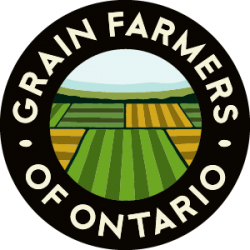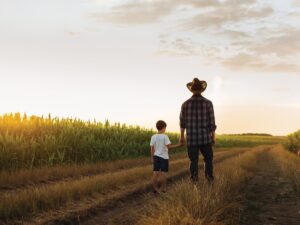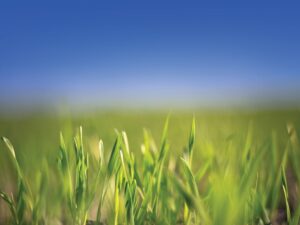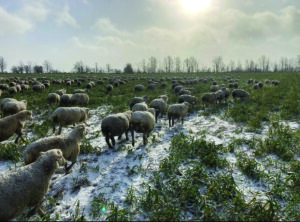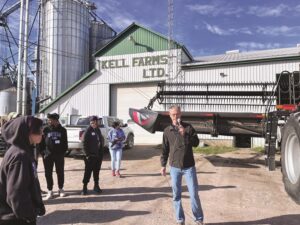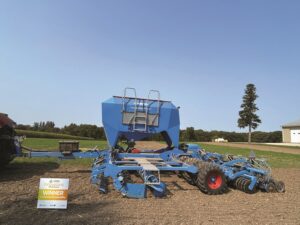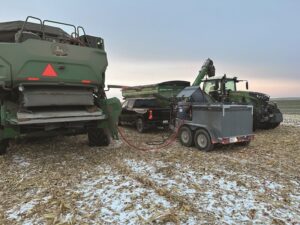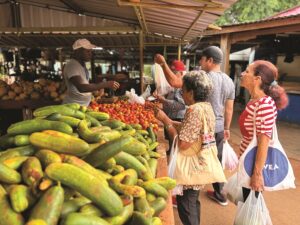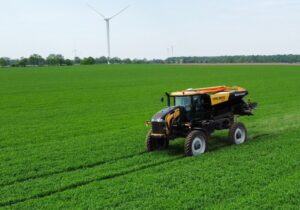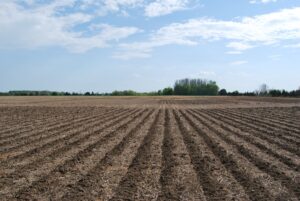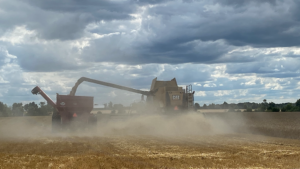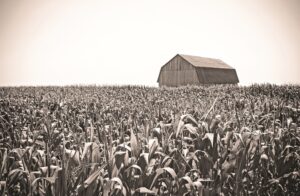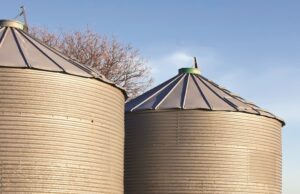Field Observations
FALL 2024
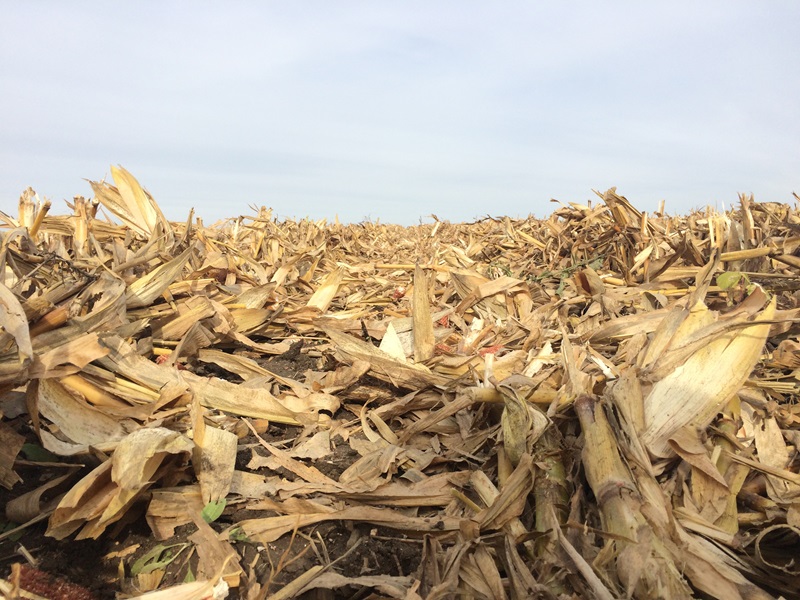
November 28, 2024
As the holiday season approaches, harvest is almost entirely wrapped up across the province. Unlike some years, November harvest conditions have been excellent, and farmers have not had to battle to get the crop off.
Corn
Corn harvest is almost finished and is 99 to 100 percent complete province-wide. And not a moment too soon, as there looks to be the potential for some snow accumulation this week.
It is now firmly seed-selling season. Be sure to consider the year and what worked and what didn’t work. If there were any resistance issues (insect or weed) this year, be sure to create a resistance plan that might include rotating crops, selecting appropriate traits, treatments, and herbicides/insecticides/fungicides to manage the concern, keeping best management practices at top of mind. Always ensure that traits and applied products will be accepted in the target market and that all labels are followed. For more considerations when selecting seed, view this factsheet.
Cereals
Before the snow flies is a great time to assess initial winter wheat stands to diagnose issues that might have occurred at planting and be best prepared to manage the crop when spring arrives.
Planting depth and uniformity are key factors to look at. Another item to note is weed pressure. Take notes that can be referenced in the winter when speaking to an agronomist about future plans.
Noting the stage of the crop and how uniform it is will be important in the spring when management decisions need to occur. Currently, across the province, winter wheat fields are staging field to field from growth stage (GS) 13 (three leaves unfolded) up to GS 22 (main shoot and two tillers). Tillers produced in the fall will contribute more to the grain yield than those produced in the spring. It is wise to compare the growth stage from field to field for management decisions and within the field (did some plants or areas emerge later or have a harder time emerging due to crop residue). For more information on crop staging and key yield components, please visit A Visual Guide to Winter wheat staging.
Crop Chats
As the field season winds down, meeting season ramps up. Start reflecting on management ideas for the next cropping season by watching the recently released Crop Chats. Learn from farmers across the province as they share actionable information on a wide range of subjects. Success, challenges and solutions are shared in two video series, the first on seeding equipment decisions and the second on winning with no-till.
This video series by the Ministry of Agriculture, Food, and Agribusiness is supported by Grain Farmers of Ontario.
November 21, 2024
As we head into the final stretch of corn harvest, pay attention to the stalk integrity of any corn still waiting for harvest—and learn more about managing high residue from high yields.
Corn
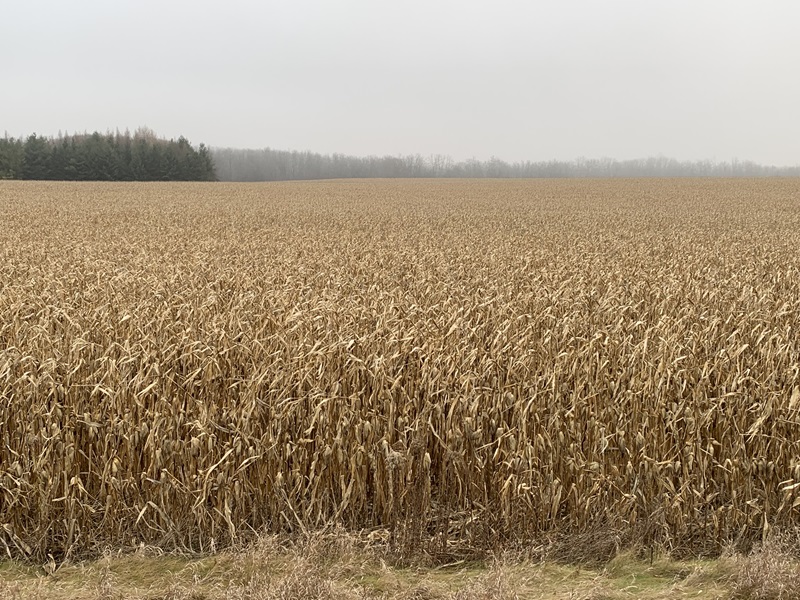
Corn harvest is 90 to 100 percent complete. Many areas have completed harvest, but some are still working on it. Rainfall these past couple of days will slow harvest progress.
As the year progresses, the stalk integrity of corn becomes a main concern. In many fields, it is evident that stalk breakdown is occurring, especially above the ear. Poor stalk integrity can lead to lodged corn, harvest issues, and reduced yields. Learn more about identifying whether a field should be prioritized for harvest due to poor stalk strength and measures to consider for future years with regard to stalk integrity in this Grain Farmers of Ontario factsheet.
With high yields comes high residue. High residue in corn fields this fall could cause some challenges in 2025 at planting. Lots of crop residue will require some extra management to ensure a good seedbed and planting results next spring. Ensure that planting equipment can handle the residue with the correct positioning of trash whippers to displace coarse residue and that the planter coulters can penetrate the soil to a uniform depth. Check that trash whippers are not too deep that they create furrows. If aiming to use a system that is not strictly no-till, some opt to use high-speed discs or vertical tillage machines to incorporate some of the residue. Tillage can help manage residue (by bringing up the soil and mixing it with residue, allowing for microbes to break down residue—just be aware of C:N ratios as breakdown occurs, especially if spring tillage). Future considerations may include using a chopping corn head or chop stalks after harvest and then utilizing a high-speed disc or vertical tillage if tillage is an option in the system.
The 2024 Ontario Hybrid Corn Performance Trials are now available at GoCrops.ca. The Ontario Corn Committee (OCC) conducts trials at multiple locations across the province. Grain Farmers of Ontario is a committee member.
Soybeans
The soybean harvest is 99 to 100 percent complete—just a few remaining acres will be harvested as weather allows.
Join Horst Bohner, Ministry of Agriculture, Food and Agribusiness, in the most recent Grain Farmers of Ontario GrainTALK Webinar, 2024 Soybean Season Recap: Key Insights and Future Strategies for 2025. Horst shares key agronomic learnings from the 2024 season and what to consider for the 2025 season.
Cereals
With most winter wheat planted in seasonally dry conditions, timely rains this fall have really helped fields germinate and emerge. And with the seasonally warm fall, even later-planted wheat fields look good. Fields are staging from seedling growth (GS13 to 19) up to tillering (GS 21).
The 2024 Ontario Cereal Crop Committee spring cereal report is now available at GoCrops.ca.
November 14, 2024
Corn harvest is closing in on the finish line. In the final stretch of the harvest season, keep farm safety top of mind.

Corn
Corn harvest has had an incredible run this year, spurred on by favourable weather and suitable grain moisture at harvest. Harvest is 85 to 100 per cent complete provincewide. With snow in the long-range forecast (for the Elora area, at least), the push will be on to get the remaining acres taken care of. Overall, yields have been strong on this year’s corn crop.
As harvest wraps up, review what worked and what didn’t and consider what can be done differently for future seasons.
Crop Protection Hub
As plans are made for next year, keep in mind the Crop Protection Hub. This hub showcases insect, disease, and other crop management strategies. It is a great reference for growers to find information on several crops and how to manage crop production challenges with insects, disease, and more.
Farm Safety
Keep safety at the top of mind. Revisit this past GrainTALK webinar on Grain bin safety with Dean Anderson of Workplace Safety and Prevention Services (now retired).
A reminder that working while tired can be a dangerous thing. Research shows that being awake for 21 hours equals a blood-alcohol level of 0.08, the legal limit in Canada. Fatigue is one of the most common hazards on the farm but is very underestimated. More from the Canadian Agricultural Safety Association here.
November 7, 2024
Corn harvest continues at a rapid pace, with some farmers completing corn harvest earlier than in past years.
Corn
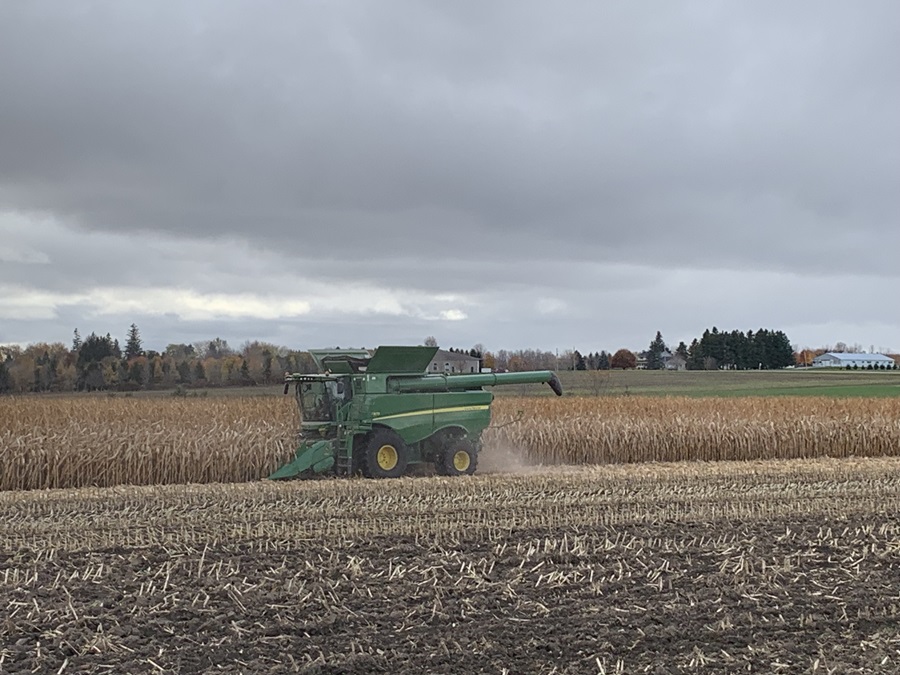
Corn harvest is roughly 55 to 80 per cent complete provincewide; corn moistures range from high teens to mid-twenties, with strong yields. Rain delays over the last week have slowed harvest slightly. However, with soils being so dry prior to rains, moisture was quickly absorbed, allowing harvest to continue once rains passed through.
Seed sales season is approaching. The best discounts and selection of the best hybrids are now. Getting some seed on the books is important so the right hybrids will be at your dealer’s location or in your shed for spring. As your needs may differ from last year, you should ensure you work on your seed selection plan and take in the three key factors of your seed selection to make sure you plan what you need to plant next spring.
Seed Selection Criteria
Agronomic package – consider maturity, disease tolerance, and matching genetics to your management and needs. Consider test weight, dry down, husk cover, plant height, and pollination timing.
Right insect traits – use the traits for your needs and field conditions. Don’t use the wrong traits if you have insect resistance issues like corn rootworm. Create an insect resistance plan on your farm. See Field Crop News for more details.
Consider the end in mind – who you sell your grain to is your customer; make sure you find out what your customer’s needs are and ask what kind of product they are looking for or do not allow. It may be traits that are not approved, or they may need specific quality parameters such as low DON levels or a specific test weight. Knowing your market today helps you plan your crop for next year.
Remember, don’t pick hybrids based on any season or location when choosing hybrids. Look at multi-year evaluations across different environments and compare them to products you know. The results of the Ontario Corn Committee (OCC) trial found at GoCrops.ca will be published in the upcoming month. The trial data includes head-to-head comparisons of hybrids, which can be viewed using the Hybrid Comparison Selector on the OCC website.
Remember to select a package of hybrids that you are comfortable with, have experience with, and know how to manage. Growing a package of hybrids spreads risk by spreading the pollination period and diversifying your investment. Grain Farmers of Ontario has created a short fact sheet on seed selection.
Soybeans
Soybean harvest is 95 to 100 per cent complete in most areas. The remaining acres will be harvested as weather and field conditions allow.
Join Horst Bohner, Ministry of Agriculture, Food and Agribusiness, in the most recent Grain Farmers of Ontario GrainTALK Webinar, 2024 Soybean Season Recap: Key Insights and Future Strategies for 2025. Horst shares key agronomic learnings from the 2024 season and what to consider for the 2025 season.
When choosing soybean varieties for the next year, be aware of what varieties have done well on-farm and in the area, and remember to look at multi-year trials, not just one season. The Ontario Soybean and Canola Council (OSACC) will post multi-year trial data later this month at GoCrops.ca. Remember that early order and early pay discounts from seed suppliers are approaching quickly; take advantage of these if possible.
October 31, 2024
Snow and ice pellets were in the air this past weekend in various regions of the province, reminding us that winter is coming. Harvest progress remains strong, with overall favourable weather allowing harvest to progress rapidly with strong yields and good crop harvest moistures and field conditions.
Corn
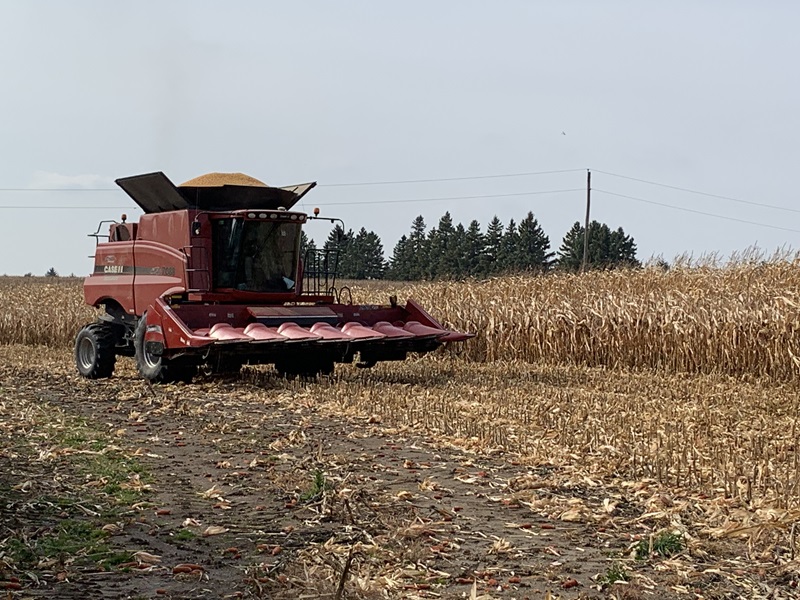
Corn harvest is between 40 to 60 per cent complete. Grain moisture has dropped quite a bit from the start of harvest with all the beautiful seasonably warm weather, which will certainly help with drying costs and ease of harvest. Harvest moistures range from the high teens to mid-20s, with many pleasantly surprised by lower harvest moistures.
The 2024 Ontario Grain Corn Ear Mould and Deoxynivalenol (DON) Mycotoxin Survey is now available. Although this survey doesn’t cover every cornfield in the province, it does cover a broad area. It gives an overall perspective of the trends of potential DON and regions with elevated levels that may need early harvest and to be dried quickly. Even if the area is relatively uninfected, field scouting is still important to understand if ear moulds are present before harvesting. Grain Farmers of Ontario support the survey.
Soybeans
The soybean harvest is 98 to 100 percent complete. The remaining acres are those planted late, double-crop soybeans, or fields that just have not yet seen a combine for harvest.
Cereals
Some areas in the deep southwest were still planting wheat last week – however, the remainder of the province has parked the planters due to winter just around the corner.
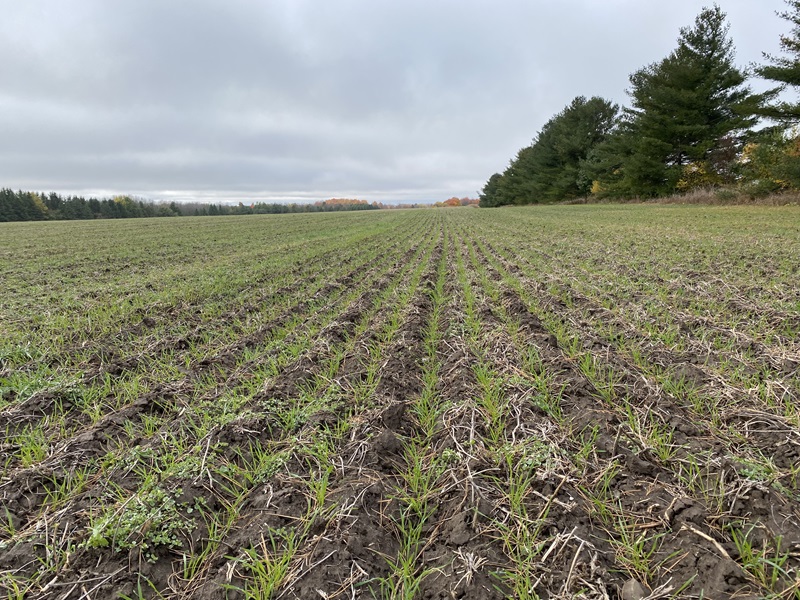
Winter wheat continues to germinate, emerge, and grow well with favourable temperatures this fall. The rain that arrived earlier this week was appreciated. Emerged winter wheat is staging from GS 10 (first leaf through coleoptile) to GS21 (one tiller). It takes 80 growing degree days (GDD) for germination and an additional 50 GDD for each inch of planting depth for emergence to occur. It takes roughly 80 to 90 GDD for each subsequent new leaf to appear.
As temperatures begin to drop, winter wheat begins to acclimate to the cold. Certain genes within wheat produce a substance that protects the cell membranes. In a wheat plant that has developed a minimum of four to five leaves and one to two tillers, cold acclimation begins when soil temperatures at the crown go below 10° C. If the plant is not at this stage, the lack of tillers heading into winter can result in an inadequate number of heads the following year, affecting yield. Tillers can still develop in the spring, but the yield potential may differ between tillers formed in the fall and tillers formed in the spring. It takes approximately four to six weeks with soil temperatures below 10 °C at the crown depth for the wheat plant to fully harden. The colder the soil, the more quickly the plants develop winter hardiness. The fluctuating air temperatures we see also influence soil temperature to a point. Once the cold acclimation begins in the fall, wheat plants can unharden when soil temperatures at the crown go above 10 °C and will re-harden when the soil at the crown goes below 10 °C.
October 24, 2024
As October slips by, excellent weather has allowed many acres to be harvested in almost ideal conditions. Soybean harvest is close to wrapping up in most areas while corn harvest continues.
Corn
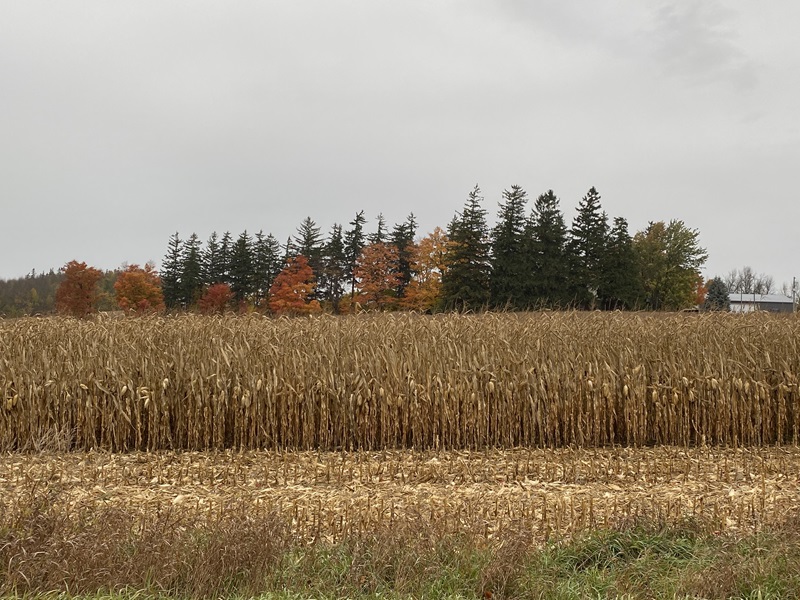
Corn harvest is approaching 20 to 30 per cent complete in many areas of the province. Moisture levels range from the high teens to the high twenties, with average yields.
The 2024 Ontario Grain Corn Ear Mould and Deoxynivalenol (DON) Mycotoxin Survey is now available. Although this survey doesn’t cover every cornfield in the province, it does cover a broad area. It gives an overall perspective of the trends of potential DON and regions that might have elevated levels that may need early harvest and to be dried quickly. Even if the area is relatively uninfected, field scouting is still important to understand if ear moulds are present before harvesting.
The importance of correct sampling for DON testing cannot be stressed enough. Ensure that there are several probe samples (minimum four probes per load) of whatever is being sampled (bins, wagons, trucks), or if using the tailgate dip option, sample several times (200 dips of the bucket through the grain stream is the gold standard). At least two kilograms of grain should be sampled and ground for DON testing. Ensure that the grain is ground finely enough that 95 per cent of the material goes through a 20-mesh screen. Once the grain is ground and uniformly mixed, a subsample can be used to do the DON dip test. This will ensure a more reliable and repeatable DON level measured. For more information on testing for DON, view the Grain Farmers of Ontario Testing for DON Factsheet.
Soybeans
Soybean harvest is 95 to 100 per cent complete across the province; some areas are still harvesting due to later planted soybeans, rains delaying harvest or other delays.
It is almost time to pre-order seed for the next season. Take a look at some considerations when selecting seed here.
If you’re feeling stressed because harvest has not gone as planned, Grain Farmers of Ontario shares resources for managing stress.
Cereals
Winter wheat planting is still occurring in the deep southwest; however, it will be wrapping up in the coming days. This fall has certainly allowed for incredible weather to get winter wheat seed germinated and plants developing.
October 17, 2024
It certainly looks and feels like fall now, with cooler weather, rainy days, and harvested fields. The soybean harvest is coming to a close, while corn harvest is gearing up.
Corn
Corn harvest is ongoing across most of the province, with 10 per cent harvested.
Dry-down in corn has been rapid. Dry-down is all due to relative humidity. In recent weeks, there has been low humidity, which has really helped take moisture points off corn in the field (and in the bin for those using air dryers on lower moisture corn).
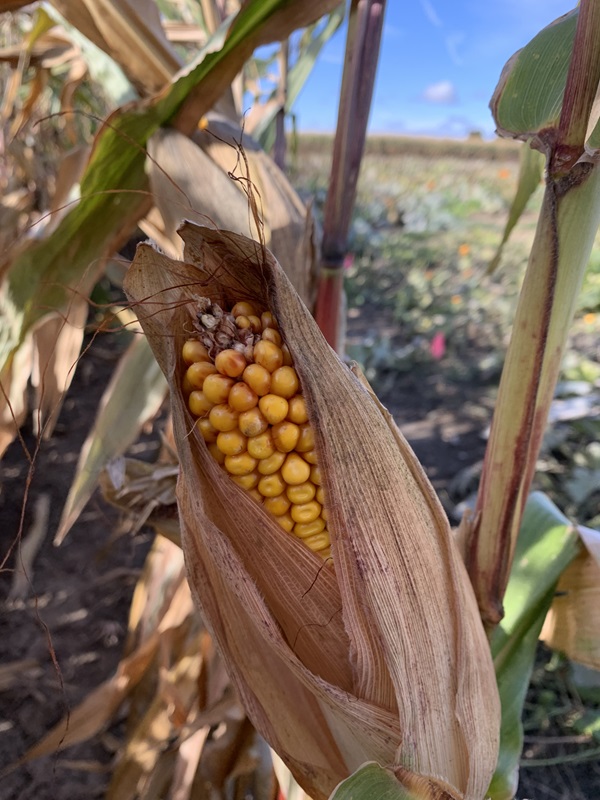
Although yield is typically at the top of every farmer’s mind, test weights also come into play. Test weight is used as a quality measurement and is identified as the weight of grain (how many pounds per bushel). Test weight depends on grain moisture, so basing the final test weight off dry grain is important. Test weight can wreak havoc as low-test weight grain lowers the grade level, which means discounted corn when selling a lower-graded product. High-test weight corn will weigh more per volume. Some might anticipate that good yields will coincide with high test weights and vice versa- but not always. There is high variability and an overall lack of relationship between yield and test weight. Many factors influence test weight: hybrid, the physical characteristics of kernels, kernel moisture, and stress during the grain fill period all affect test weight. Disease, insect damage, deficiencies and events such as frost, drought, and hail can also affect test weights due to premature plant death and premature plant maturation, which means less starch in the kernel and low test weight.
Although DON isn’t on everyone’s radar this year, the Ontario Grain Corn Ear Mould and DON Survey has been conducted. The report for 2024 should be available within the next couple of weeks. To learn more about DON and what to do should it be in a grain sample, visit the Grain Farmers of Ontario Factsheet.
MSc. candidate Tuesday Kristiansen and Grain Farmers of Ontario staff hosted a GrainTALK Webinar: Management Strategies and Innovative Research on Corn Rootworm. Kristiansen shared the lifecycle of corn rootworm, current tools, best management practices, and her research on entomopathogenic nematodes to manage corn rootworm. Grain Farmers of Ontario funds this novel research.
Soybeans
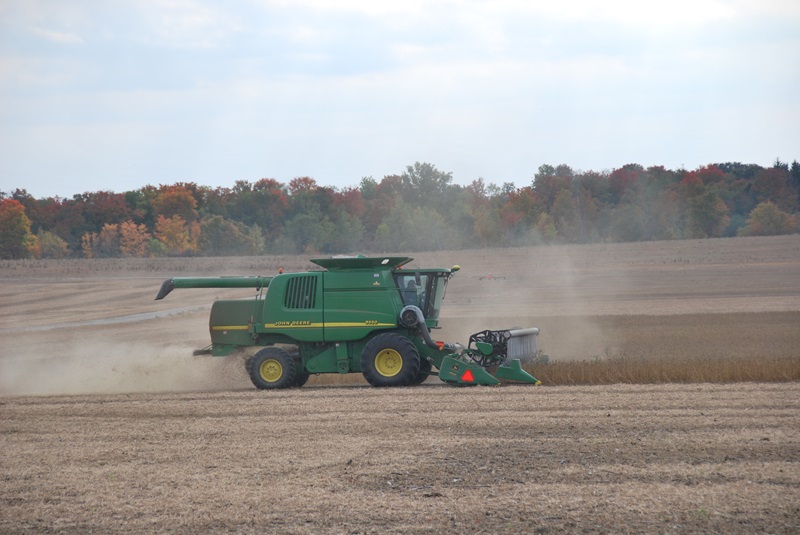
Soybean harvest is getting closer to the end, with an estimated 90 to 100 per cent complete across the province, with many finishing harvest earlier than normal due to the incredible weather received.
Now is a great time to do some post-harvest scouting and weed management. What weeds were hard to control, and how can they be better managed? As cooler temperatures approach, perennial plants are actively putting energy into the roots and crown of the plant. Don’t expect immediate results when spraying a herbicide this time of the year. It takes time for the herbicide to translocate within the plant, which is driven by temperature, but leaving the plant for a few days before any fall tillage can really assist with the management of tough-to-control perennials. Much of the province has had its first (or more) hard frost, but some areas might still be able to take advantage of a great window for weed control.
In some cases, weed control can be better after a hard frost as the plant moves nutrients and herbicide into the roots. The key is to choose the proper herbicides for this time of year. Use multiple modes of action and a herbicide that is preferably not a “contact herbicide.” Adjust spray timing for the warmest part of the day for better plant uptake, and be prepared to wait a bit for control to occur. Learn more in this article, Weed Control Tips.
Cereals
Winter wheat planting for the majority of the province has edged past the optimum planting date. Agricorp 2025 Fall Planting Deadlines have also passed for some areas of the province, with others approaching shortly.
October 10, 2024
The past week saw exceptional harvest weather. Soybean harvest continues, while corn harvest is beginning to ramp up in some regions of the province. Winter wheat planting is continuing.
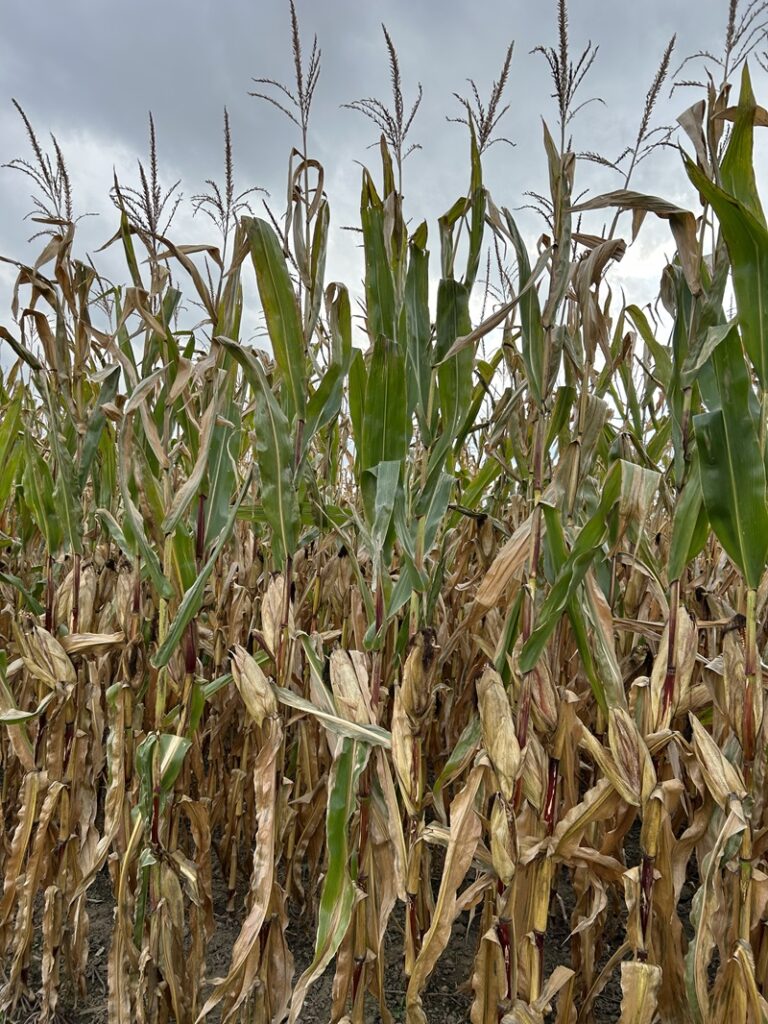
Corn
Corn harvest has begun in areas with shorter day hybrids, areas with low moisture causing plant dry down earlier, and/or fields that might have been impacted by diseases such as tar spot (which caused plant death). Later planted corn is close to or at black layer. Aim to make alternative plans, such as silage, for corn that will not reach black layer prior to plant death.
Over the past two months, tar spot has severely impacted some corn fields. As fall harvest approaches, it will be critical to prioritize infected fields for early harvest. Stalk integrity is deteriorating, and fields that were unsprayed and impacted should be harvested first, followed by fields with more susceptible hybrids (lower tolerance to tar spot). Keep track of yields, moisture, test weights and grades. Depending on when the plants were impacted can greatly determine yield loss and low-test weights. Keep notes on hybrid differences and how fungicide spray programs helped (fungicides give protection for a certain length of time). For more information on stalk integrity, please visit the Grain Farmers of Ontario Factsheet.
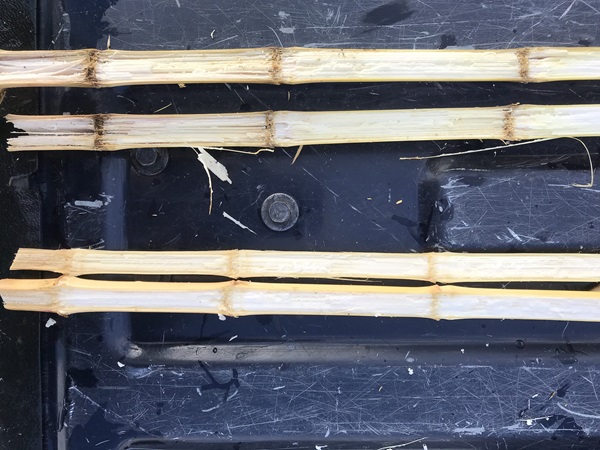
Some corn fields are seeing ear tip back in the fields this year. Tip back is when corn kernels do not extend to the tip of the corn cob and have missing or incomplete kernels. Typically, there are two main reasons for tip back: poor pollination (causing the absence of kernel formation) and kernel abortion (smaller kernels that have been shut down early). If tip back is being seen in the field, take some time to assess the main contributor.
Silks that emerge from the tip of the cob are the last to emerge through the husk, and these kernels are also the last to fill during the grain fill period. Any significant stresses before, during and right after pollination will impact these kernels. Delayed or late silking is when silks emerge when there is little to no pollen left. Corn rootworm beetles can also clip silks, resulting in poor pollination as well.
Kernel abortion is mainly caused by stresses that reduce plant photosynthetic output (drought or disease can cause this) during the first several weeks following pollination and through the R3 (milk) growth stage. Also, many days of cloudy weather can reduce plant photosynthesis and cause kernel abortion.
Watch the newly released GrainTALK Webinar: Management Strategies and Innovative Research on Corn Rootworm, with MSc. candidate Tuesday Kristianson as she shares the corn rootworm lifecycle, current tools, best management practices and her research on Entomopathogenic Nematodes to manage corn rootworm, which is funded by Grain Farmers of Ontario.
Soybeans
Soybean harvest is 60 to 100 per cent complete, depending on the region, with most soybeans coming off the field dry or close to dry (10 to 16 per cent moisture). Fields planted later are seeing slightly lower yields, and areas planted into less-than-perfect field conditions are also showing lower yields due to emergence issues and/or water ponding after planting issues.
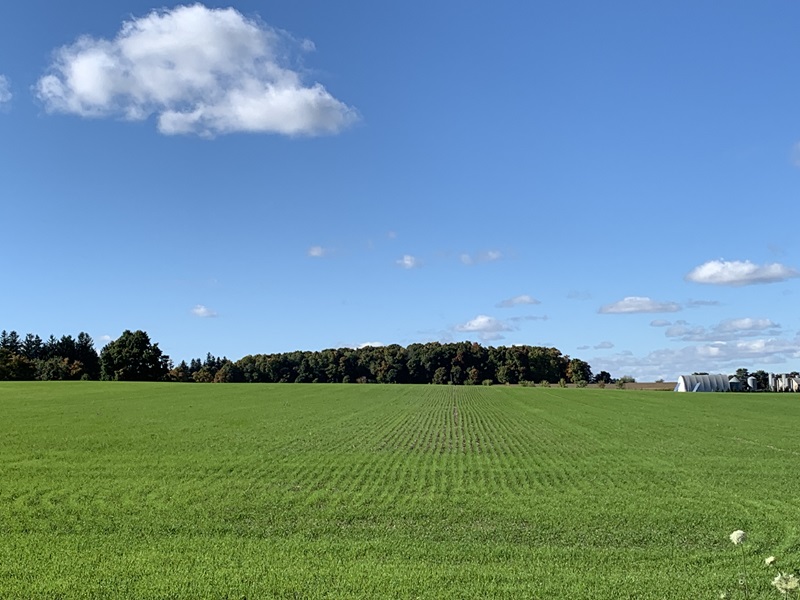
Cereals
Winter wheat planting is still occurring as conditions and calendar dates allow. Winter wheat that was planted earlier in the season is staging from emergence to the seedling growth stages (GS 10 to 19). Wheat needs 80 GDD to germinate and 50 more GDD per 2.5 cm of seeding depth to emerge. With warm temperatures in the past weeks, wheat emergence and development have been rapid.
October 3, 2024
Soybean harvest continues across the province, with steady progress in the north and east, while the southwest has been in a holding pattern due to the remnants of Hurricane Helene last weekend. Corn harvest is slowly starting as dry areas have reported corn moistures down to 20 per cent. Winter wheat planting continues; pay attention to seeding rates as the season progresses.
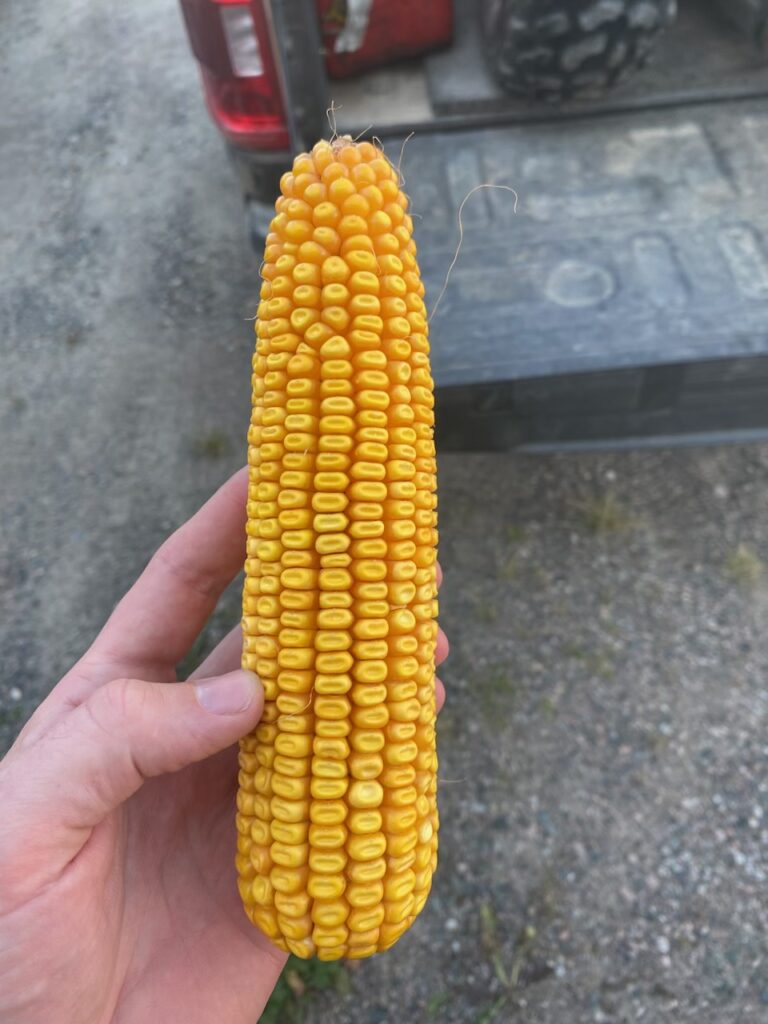
Corn
Corn harvest will begin soon as fields dry down. At this point in the year, it can be expected that grain will dry down slower than in September. On average, in the fall, it’s typical to expect three days per point of moisture. Tar spot has impacted many fields in western Ontario and has caused earlier plant death. Impacts to test weight and yield will depend on hybrid susceptibility, fungicide application and the crop’s growth stage when tar spot started development.
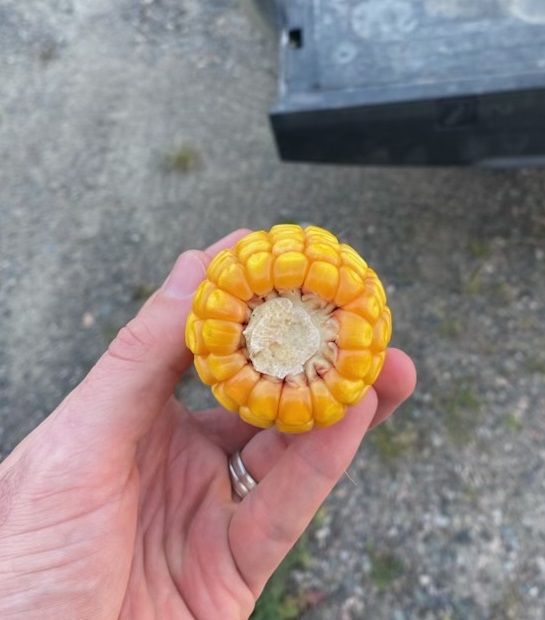
So far, many have escaped killing frosts with warm temperatures occurring, but in the coming month, there will most likely be hard frosts arriving in regions of the province. Frost injury can more easily harm leaves than the stalk, leaving leaves to look water-soaked before the leaf turns brown and die. If the grain has not reached maturity (black layer), yield and test weight can be reduced. To learn more about the impact of frost damage on corn, visit here.
Gibberella ear rot produces the mycotoxin DON in corn and is beginning to be a topic in corn fields; learn more here. Be prepared to manage infected fields with a timely harvest, drying the grain quickly and storing it separately from non-infected grain. The Ontario Grain Corn Ear Mould and Deoxynivalenol Mycotoxin Survey will be published later this month.
Seed selection season is coming up. Check out the Choosing the right seed factsheet for more information on how to make seed selection decisions.
Soybeans
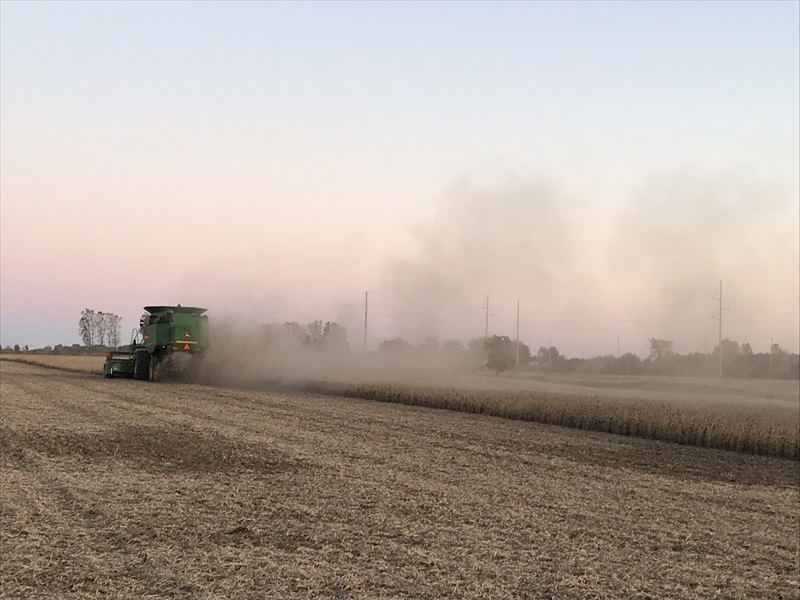
Soybean harvest has continued, as conditions allow, with 15 to 30 per cent complete, with moistures from 11 to 16 per cent and average yields.
With many late-planted soybeans this year, there may be some discussion on spreading treated wheat seed on standing soybeans. This is NOT recommended.
Aerial or broadcast spreading of treated wheat seed over a standing crop of soybeans is not recommended because:
- Tolerance for treated seed in a grain shipment is 0 per cent. Any treated kernels found in a shipment will see the entire load rejected. Fines and penalties can be imposed when grain safety standards, including grain contamination tolerances, are not met.
- Treated seed can land on the standing soybean plants and rest in the branches of the plant. Harvesting the soybean crop with seed on the plants will undoubtedly lead to treated kernels ending up in the harvested grain.
- Air reels can blow treated seed into the header, allowing for treated seed contamination of the soybeans.
- Wheat seed placed on the surface will have lower germination rates and potential for a very uneven stand of winter wheat with a variable population as seed will only germinate where conditions are favourable, such as areas with higher surface moisture or will be dependent on rainfall for germination. Seed-to-soil contact is key.
- Broadcast or aerial seeding over the surface results in shallow roots and surface crown root development. This leads to higher stand losses due to freeze damage in winter or heaving during the spring heaving cycles.
- Broadcasting with a tractor and spreader tramples soybean rows if tram lines are not already in place, lowering the soybean yield. If conditions are wet, compaction will occur.
Be sure to reduce the risk of treated seed contamination. If equipment is used to handle treated seed and harvested grain, review the Grain Farmers of Ontario Handling treated seed factsheet for more information.
Cereals
Winter wheat planting is still going strong, as ground conditions allow. Wheat that has been in the ground for a couple of weeks is emerging. A Visual Guide to Winter Wheat Staging is a great way to know what stage crops are at, and it shares key yield components, scouting tips, and more.
As a reminder, the Ontario Cereal Crops Committee publishes a guide to Ontario’s optimum winter wheat planting dates. For areas that have passed the optimum winter wheat planting window, there may still be time to plant before the Agricorp 2025 Planting Deadlines for fall-seeded grains. Just ensure that seeding rates are increased accordingly; 200,000 seeds should be added to the equation for each week delay after optimum, with 2.2 million seeds being the per acre maximum rate.
Spring cereal harvest is wrapping up in the northern area of the province.
Cover crops planted after wheat are looking great as fall arrives.
September 26, 2024
The soybean harvest saw a good few days of productivity last week and into the weekend, but rains have put harvest and winter wheat planting on hold for much of the province. Pay particular attention to optimum winter wheat planting dates and increase seeding rates accordingly.
Corn
Corn is anywhere from a black layer to 1/4 milk line in most areas. Warm days in the past couple of weeks have really helped advance corn. With exceptionally warm, dry weather, grain moisture could decrease by one point per day. As October approaches, with cooler weather and some showers, it will be common to need approximately three days to remove one point of moisture.
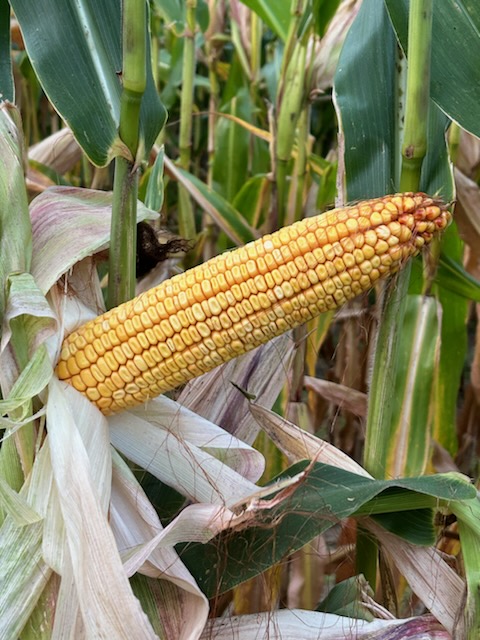
Are there lodged corn plants in your fields? Was corn grown in the same field last year? Are the roots small and look pruned? Now is the time to diagnose why things might not look as good as they should. Corn rootworm, poor root development from compaction, and poor hybrid selection can cause standability concerns. Be sure to take the time to determine which factor is affecting corn stands and make better choices for next year! Find out more in the managing corn rootworm resistance factsheet.
Gibberella ear mould has appeared in some locations. Most of the crop has looked to be free of ear mould, until now. The crop was infected during pollination with ideal moderate temperatures and humidity, aiding in infection of the silk channel. Conditions after infection will lead to the actual development of the visual symptoms of ear mould that are just now being observed.
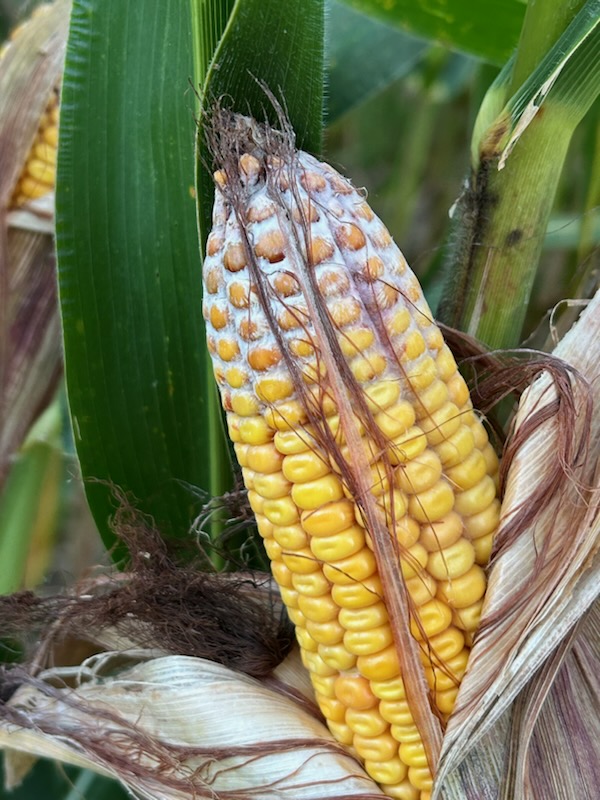
The past few weeks of morning fog and heavy dews have led to higher humidity in the canopy, which fuels this disease. Areas where fields do not dry out as quickly, like around tree lines and buildings, should be the first place to scout. Fields and hybrids with open husks will have an environment of dryer conditions, which will limit disease growth. Look for the tight-husked plants to find if mould is present. Identify fields of concern and be sure to manage them this fall by prioritizing harvest and quickly drying down to limit the amount of DON that gets produced. Wet, cool conditions will favour DON production. Read more information on DON in corn.
Soybeans
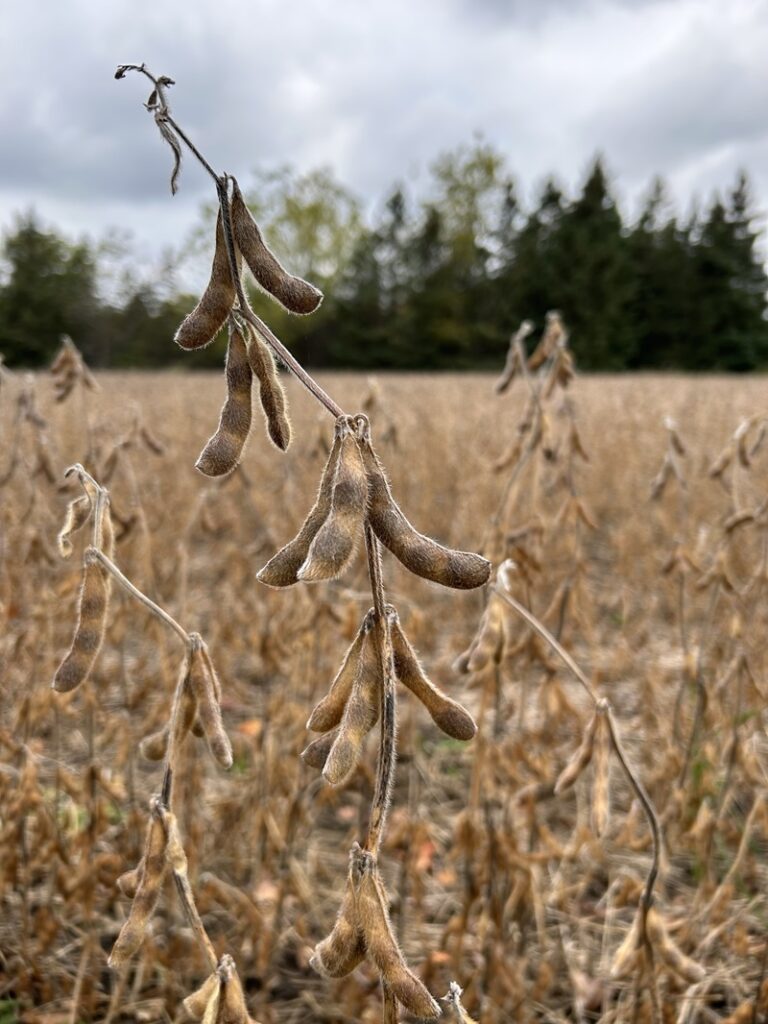
Soybean harvest is continuing across the province as weather and plant maturity allow, with five to 10 per cent harvested. As there was an extended hot, dry period approaching soybean harvest, there were some reports of soybeans being harvested below 13 per cent. Harvesting below optimum harvest moisture can impact revenue through reduced delivery weight and shatter loss and splits. With rain arriving earlier this week, it should help the moisture of the soybean seed return to a moisture that is more desirable for harvest.
Soybean harvest started slightly earlier than some years. There are some great advantages to harvesting early: timely wheat planting, reduced soil compaction from typically wet fall soils later in the year, earlier fall tillage, and the ability to switch to corn earlier are some of the benefits.
The Soybean Cyst Nematode Coalition has named National Nematode Day October 1, 2024, to increase awareness around this yield-robbing pest. To learn more about SCN, visit the SCN Coalition.
Cereals
Winter wheat planting is occurring, with some areas planting earlier than normal. A nice rain across most of the province will ensure moisture for wheat to germinate, especially in areas lacking moisture.
For several regions, the optimum date for planting has passed, while in other areas, it is approaching. As optimum dates approach, the seeding rate should increase. 1.4 to 1.6 million seeds per acre is recommended for early planting. Two hundred thousand seeds should be added to the equation for each week’s delay after optimum, with 2.2 million seeds being the per acre maximum rate. The later winter wheat is planted into the season, the lower the number of tillers will develop, and the higher the seeding rate will help compensate.
Spring cereal harvest, oats, in particular, is still occurring in the northern portion of the province.

